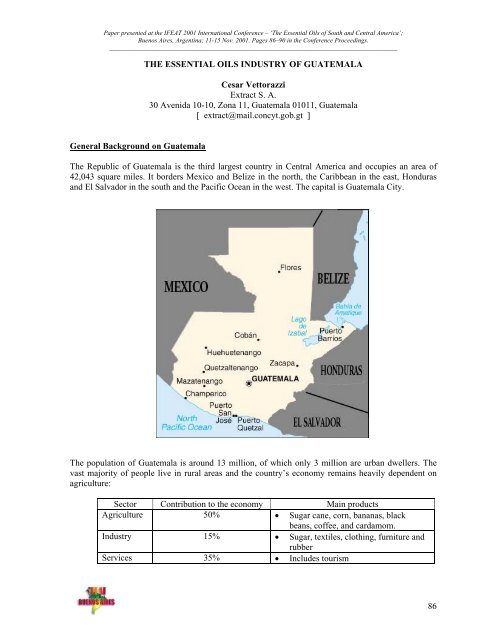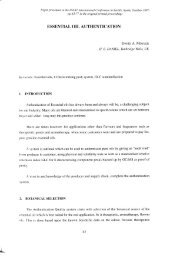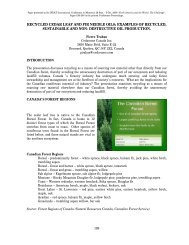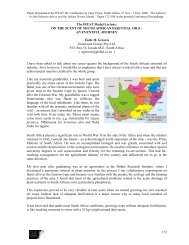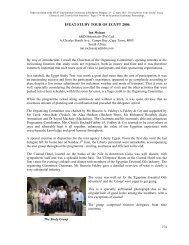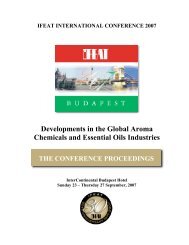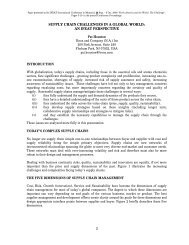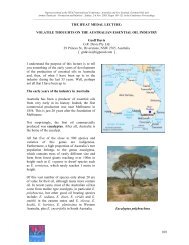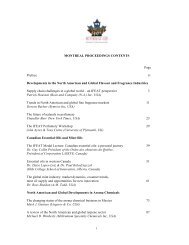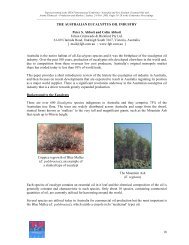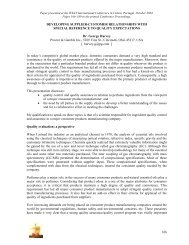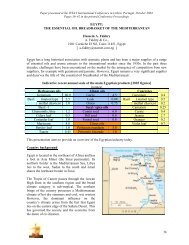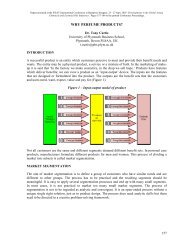THE ESSENTIAL OILS INDUSTRY OF GUATEMALA Cesar ... - IFEAT
THE ESSENTIAL OILS INDUSTRY OF GUATEMALA Cesar ... - IFEAT
THE ESSENTIAL OILS INDUSTRY OF GUATEMALA Cesar ... - IFEAT
You also want an ePaper? Increase the reach of your titles
YUMPU automatically turns print PDFs into web optimized ePapers that Google loves.
The Essential Oils IndustryToday, Guatemala is best known today as a major origin of cardamom oil and West Indian typelemongrass oil and as a minor supplier of a couple of other oils.Table 1: Summary of the production of essential oils in the late 1990s(tonnes/year)West Indian lemongrass 50Cardamom 9-10Palmarosa 4Key lime
Table 2: Production of citronella and lemongrass oils, 1930-2000(tonnes/year)Citronella Lemongrass1930s 40 141940s 30 611950s 73 1421960s 115 1661970s 118 160Late 1990s 4 50Source : Central Bank of GuatemalaIn the immediate post-WWII years, there were 5 main producers but by the early 1970s the numberhad increased to almost 50 producers with many cultivating their own plantations. The productionareas were located on the Pacific coast and the country’s northern borders, where the soils are rich andthe rains are regular.The appearance on the market of synthetic products during the 1960s pushed the Essential OilProducers Association to improve their production technology, reduce costs and to achieve a higherdegree of quality. In 1964, an experimental station and a research laboratory were established tofurther these aims and in 1967 a high vacuum-fractionating column was acquired for the production oflemongrass and citronella derivatives. This period also saw the development of new markets in Japan,the Soviet Union and, in Mexico, the new fragrance factories became dependent almost exclusively onthe Guatemalan oils.Since the 1980s, production of both oils in Guatemala has reduced in response to the scale of globaldemand, increased local labour costs, price competition from Asia and the greater profit attainablefrom cultivation of sugar cane.The position today is as follows:• the production of both oils is restricted to 3 or 4 companies;• citronella output has reduced to a mere 4 tonnes annually; and• lemongrass production is around 50 tonnes annually.In the case of lemongrass, however, Guatemala retains its long established role on the world market asthe preferred source for a high quality productCardamom OilThe cardamom plant was introduced in the early years of the twentieth century. Production of the spiceexpanded after World War I, largely on the farms of German immigrants in the northern part ofGuatemala, and exports developed to Europe of decorticated seeds.Another growth phase in spice production commenced with World War II. However, the Guatemalangovernment expropriated the farms owned by German immigrants on the entry of the United States tothe war. This resulted in a fall in output since the new government appointed managers lackedhusbandry knowledge.A third phase of spice production expansion occurred in the 1970s and this has resulted in Guatemalaachieving the position of the key player on the international cardamom market. Today, most of the88
spice is produced by smallholders in forest areas, both in the northern and southern areas of thecountry.Guatemala started to produce small quantities of cardamom oil in 1945. However, significant scaleproduction did not occur until the 1970s when loose seed as feedstock became readily available.Table 3: Cardamom spice and oil production, 1970 - 2001(tonnes)Cardamom spice(whole capsules Oiland loose seed)1970 3,000 0.51975 4,000 0.81980 5,000 1.51985 5,500 2.01990 8,000 4.51995 12,000 5.51996/97 15,000 7.01997/98 17,500 9.51998/99 17,500 10.51999/2000 10,500 10,02000/2001 12,000 8.5Source: Central Bank of GuatemalaThe reduction in spice output during the 1999/2000 crop year was the result of drought damage toplantations in 1998. Oil production in 2000/2001 suffered as a result of the preceding shortage of thespice and its high purchase price. An improvement in oil output is expected from 2001/2002 sinceplantations have started to regenerate and others have been newly established.PalmarosaThe production of palmarosa oil commenced in the 1960s in the southern area of the country. Today,output is modest, 4 tonnes/year, and it arises from two farms.Lime OilKey lime fruit is a traditional smallholder crop in Guatemala and large plantations were established forthe fresh fruit export market in the 1940s. As a result of initiatives by the Essential Oil ProducersAssociation, production of the distilled oil started during the 1960s on three large plantations, one inthe northern and two in the southern part of the country. Output peaked at around 5 tonnes/year in the1980s.Today, there is a resurgence of interest in lime fruit production as part of national diversificationprogram and this could increase the output of distilled Key lime oil in the future. However, theemphasis is on the Persian/Tahitian type fruit.89


